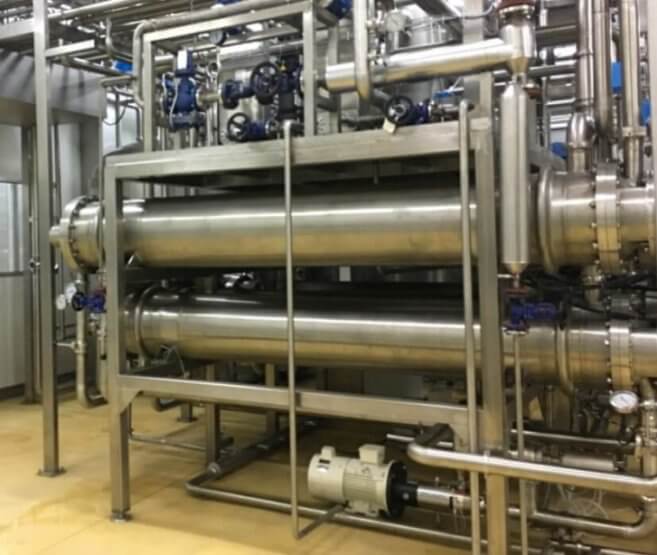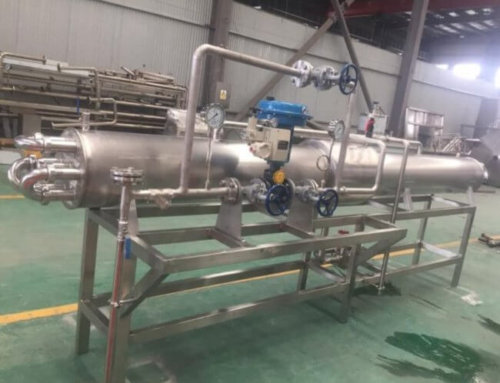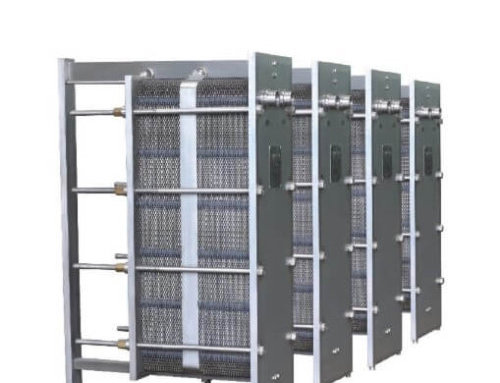Project Description
Scraped Surface Heat Exchanger
Scrape Surface Heat Exchanger Description
The scraped surface heat exchanger is short for SSHE, which is a very popular heat exchanger in the food and beverage processing field. The heater consists of a material barrel, a heating or cooling medium jacket, a stirrer and a shaft seal. The scraper of the stirrer is fixed on the stirring shaft with positioning pins. When the shaft rotates at a high speed, it will be close to the wall in the material barrel due to centrifugal force and fluid resistance, continuously scrape off the covering film of the material and liquid in contact with the heat transfer surface, and constantly clean the heat transfer surface so that new material and liquid contact the heat transfer surface again, thereby improving the heat transfer efficiency, heating steam or cooling water in the jacket flow, the conveying pump fills the material liquid and flows through the annular channel between the material barrel and the stirring shaft. The two fluids flow in the opposite direction and exchange heat through the material barrel. The passage through which the material liquid flows in the material barrel accounts for about 20%-40% of the cross-sectional area of the material barrel. When the scraper surface heat exchanger used for aseptic packaging, it is important to ensure aseptic of the shaft seal, we adopt to steam sterilization or aseptic mechanical seal shaft seal to prevent the material liquid from being contaminated by the outside when the shaft rotates.

Scrape Surface Heat Exchanger Application
This scrape heat exchanger is widely used in the production of aseptically packaged food and beverage:
- High viscosity products: tomato sauce, mayonnaise, banana puree, fruit concentrates and jams, ice cream and yogurt
- Large solid particle materials: sauce, fruit pulp
- Crystallization through cooling: margarine, fat and butter
several scraper heat exchangers are often connected in series, and the material pump will continuously pass the relatively viscous material through the heat exchanger for preheating, sterilization and cooling, then aseptically packing.

Scraped Surface Heat Exchanger Advantage
1.The scraper heat treatment system has extremely high adaptability to the types and physical properties of materials, so the function of the equipment has high scalability, and can be used to process various products with high viscosity such as cream, chocolate sauce, jam, fruit juice, etc. The sterile design can be used to make sterile products.
2.The scraper heat exchanger is a kind of heat exchange equipment especially suitable for processing viscous, high viscosity, and liquid-containing particles. The materials usually stay in the tube sheet heat exchanger for a few seconds, so the flavor and nutrition of food and beverages can be retained to the greatest extent.
3. Compared with the traditional tube or frame heat exchangers, ultra-high temperature sterilization will not produce coking film. It is a new type of food machinery and equipment specially used for instant heating or instant cooling of viscous materials, and it is a wise choice for processing viscous fluids from 200,000-1,000,000 centipoise.
4. Good sealing performance and long service life: adopt the mechanical seal designed and processed by the famous factory and fully meet the hygienic standard.
5. High heat transfer performance: precise tube wall thickness design, special process treatment and increase of effective heat exchange surface increase the heat exchange efficiency to 4-6 times that of other heat exchangers to achieve uniform heat exchange and avoid material heat transfer The surface produces crystallization and coking phenomenon, and it has the functions of homogenization and emulsification.


